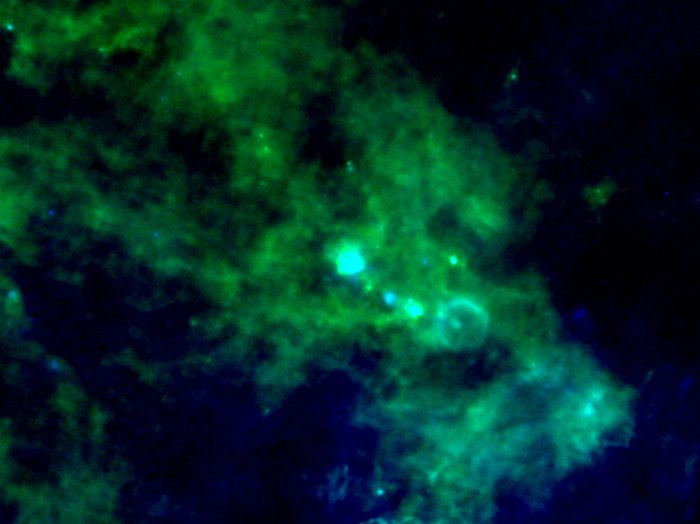http://www.esa.int/spaceinimages/Images/2016/08/Not_your_typical_protostar
http://www.esa.int/esl/ESA_in_your_country/Spain/Una_protoestrella_atipica
Una protoestrella atípica
30 agosto 2016
En el centro de esta imagen, capturada por el observatorio espacial Herschel de la ESA, descubrimos un objeto cósmico realmente peculiar: la estrella denominada IRAS 19312+1950.
Situada a más de 12.000 años luz de nosotros, lleva años confundiendo a los astrónomos, ya que muestra signos tanto de ser muy antigua como de ser muy joven.
Los científicos, por ejemplo, han detectado emisiones normalmente asociadas a estrellas de tipo tardío: óxido de silicio y máseres de hidroxilo, el equivalente en microondas a un láser en luz visible.
No obstante, también han descubierto en ella características típicas de las estrellas de tipo temprano: una nube envolvente químicamente rica como la que suele verse alrededor de estrellas jóvenes y regiones de formación estelar.
Ahora, observaciones en la banda de infrarrojos tanto de Herschel como del telescopio espacial Spitzer de la NASA sugieren que podría tratarse de una estrella en plena formación, y no de una estrella adulta o antigua. En otras palabras: una protoestrella.
La estrella es una diez veces más masiva que el Sol y emite unas 20.000 veces más energía. Parece ser rica en oxígeno y expulsa chorros de gas desde ambos polos a velocidades de 90 km/s como mínimo.
Además, está rodeada por una nube de gas, polvo y hielo —con grandes cantidades de hielo de agua y de dióxido de carbono— que la oscurece y cuya masa total equivaldría a unos 500-700 soles.
A pesar de mostrar características poco frecuentes en otras estrellas jóvenes, los astrónomos creen que se trata de una protoestrella que va acercándose rápidamente al final de su fase de acreción, periodo durante el cual aumenta de tamaño alimentándose de la materia que la rodea. Aunque hasta ahora la región no se había considerado una incubadora estelar, es cierto que muestra otros signos de estrellas jóvenes o recién formadas, lo que respaldaría esta hipótesis.
Esta imagen está compuesta por datos infrarrojos recogidos por el instrumento PACS (cámara y espectrómetro con conjuntos de detectores fotoconductores) de Herschel a 70 micras (verde) y 160 micras (azul). La investigación correspondiente está publicada en Astrophysical Journal.

- Title Not your typical protostar
- Released 30/08/2016 10:00 am
- Copyright ESA/Herschel/PACS/Hi-GAL Project, KU Leuven
- Description At the centre of this image, captured by ESA’s Herschel space observatory, is a truly peculiar cosmic object: a star named IRAS 19312+1950.Located over 12 000 light-years from us, this star has puzzled astronomers for many years because it shows conflicting signs of being both extremely old and extremely young.Astronomers have spotted signs of emission usually associated with old, late-type stars: silicon oxide and hydroxyl masers – the microwave equivalent of a visible-light laser.But they have also discovered characteristics mostly seen around early-type stars: a chemical-rich enveloping cloud usually seen around youthful stars and in regions of star formation.Infrared observations from both Herschel and NASA’s Spitzer Space Telescope now suggest that it may instead be a star in the making, rather than a fully-fledged or ancient star. In other words, it is a protostar.The star is about 10 times as massive as the Sun and emits about 20 000 times as much energy. It appears to be rich in oxygen, and has jets of gas streaming from both poles at speeds of at least 90 km/s.In addition, it is surrounded and obscured by a collapsing cloud of gas, dust and ice – including large quantities of water and carbon dioxide ice – that contains an overall mass equivalent to 500 to 700 Suns.Although it displays features atypical of its peers, astronomers believe it to be a stellar embryo fast approaching the end of its ‘accretion’ stage, the period in which it feeds upon surrounding material to fuel its growth. Although the region had not been pinpointed as a stellar nursery before, there are signs of recently formed and youthful stars nearby, supporting this idea.
- Id 364398
Not your typical protestar

- Title Not your typical protostar
- Released 30/08/2016 10:00 am
- Copyright ESA/Herschel/PACS/Hi-GAL Project, KU Leuven
- Description At the centre of this image, captured by ESA’s Herschel space observatory, is a truly peculiar cosmic object: a star named IRAS 19312+1950.Located over 12 000 light-years from us, this star has puzzled astronomers for many years because it shows conflicting signs of being both extremely old and extremely young.Astronomers have spotted signs of emission usually associated with old, late-type stars: silicon oxide and hydroxyl masers – the microwave equivalent of a visible-light laser.But they have also discovered characteristics mostly seen around early-type stars: a chemical-rich enveloping cloud usually seen around youthful stars and in regions of star formation.Infrared observations from both Herschel and NASA’s Spitzer Space Telescope now suggest that it may instead be a star in the making, rather than a fully-fledged or ancient star. In other words, it is a protostar.The star is about 10 times as massive as the Sun and emits about 20 000 times as much energy. It appears to be rich in oxygen, and has jets of gas streaming from both poles at speeds of at least 90 km/s.In addition, it is surrounded and obscured by a collapsing cloud of gas, dust and ice – including large quantities of water and carbon dioxide ice – that contains an overall mass equivalent to 500 to 700 Suns.Although it displays features atypical of its peers, astronomers believe it to be a stellar embryo fast approaching the end of its ‘accretion’ stage, the period in which it feeds upon surrounding material to fuel its growth. Although the region had not been pinpointed as a stellar nursery before, there are signs of recently formed and youthful stars nearby, supporting this idea.
- Id 364398
Guillermo Gonzalo Sánchez Achutegui
ayabaca@gmail.com
ayabaca@hotmail.com
ayabaca@yahoo.com
Inscríbete en el Foro del blog y participa : A Vuelo De Un Quinde - El Foro!

No hay comentarios:
Publicar un comentario